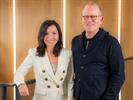Holmes Report 11 Oct 2012 // 11:00PM GMT
As chief brand-building officer at Procter & Gamble, Marc Pritchard wields a $9.3bn marketing budget, the world's largest and one that is sometimes used to stunning effect, as with the recent 'Thank You, Mom' Olympics programme.
Since a major restructure earlier this year, that remit now includes the FMCG giant's public relations activities, placing Pritchard in a unique role at the confluence of modern brand engagement and communication.
Which may be why P&G, long noted for its conservative attitude to brand-building, is starting to shake things up a little bit. Yesterday, for example, Pritchard delivered an address at an advertising conference where he compared P&G's marketing to an election campaign.
Afterwards, in a wide-ranging interview with the Holmes Report ahead of his keynote at our Global Public Relations Summit in Miami, Pritchard explained why the public relations industry needs to step up its game, particularly in terms of creativity and ideas, and its overall "assertiveness".
He also revealed how he engages the company's critics, discussed the importance of "newsroom mentality", and pondered how he would sell a career in brand communication to an idealistic, new graduate.
In 2010, you said that PR should stake its claim and own real-time marketing that targets communities. Do you feel that is happening?
I think it’s moving in that direction but not to the extent I would like to see it happening. I’m seeing, increasingly, that PR is moving to more of a realtime approach, but I think that the industry could be more assertive and aggressive about staking its claim. There’s so much that the PR industry has to offer in terms of engagement with consumers in their communities and making brands part of those conversations. We need to step up even further.
When you say the industry could be more assertive and aggressive, do you mean with you?
Yes. There are some firms that take the initiative to do that. Some are still too much in service of what we’re asking them to do. The best PR firms are the ones that are really looking at PR through the lens of creating earned awareness and persuasion - creating strategies and ideas that then can engage with the consumers and get them to buy our products on the basis of authentic stories.
So you think PR firms should challenge their clients more?
I think so. I do think that clients get what they deserve, if they are not pushing for it, they are probably not going to get it. And if they get pushed and they don’t accept those ideas, they won’t get the breakthrough. As we’ve done the reorganisation, I’m pushing our folks to be much more assertive to come up with new ways of driving
Why did you reorganise to combine communications with marketing at P&G? It’s still relatively rare to see a big company make that move.
What we did is put it under the overarching brand building remit. We made a very clear distinction to not bring PR into marketing. We felt they are really two different disciplines. Marketing still has an aspect of paid awareness and then overall brand management. Our organisation had government relations and regulatory relations - we decided they were best to reconnect with their core disciplines of legal and R&D. That will allow the remaining communications/PR function to focus on its core competency of communications, but get a much deeper connection with marketing, market research and even design.
You’ve talked about implementing a 'newsroom mentality' at P&G. Isn’t that a very difficult shift for a company of your size and age to make?
It’s actually been pretty interesting how quickly this idea has caught fire. We already had people dedicated to digital and social media work. We had PR people who were doing PR work. What we did was take existing people and reorganise them into an always-on daily newsroom mentality. The trick was creating a calendar of events - and then mastering the skills of being able to identify what’s hot. There was a lot of experimentation, but I think the idea is catching on.
The move towards a newsroom mentality has led some people to say that big set-piece campaigns are dead. Do you subscribe to that view?
I don’t think so. I think we need more campaigns. With the fragmentation that exists in the media, one of the ways that you can really engender trust with consumers is having an ongoing campaign that has some familiarity to it. It makes it easy for people to recognise this is a campaign from Pampers and now I’m going to see a message. TV campaigns are still an essential part of our business model - you need mass awareness-building activity. We’ve even found that TV combined with social media and PR is a much bigger amplifier.
The PR industry is concerned about its ability to bring research and insight into its offering, particularly in terms of getting it funded by clients. What are your views on this? Do you see any point to your PR firm bringing you insights if you are already getting them elsewhere?
That’s an interesting question, which I’m not sure I’ve thought about. Insight is so fundamental - you have to have it to make any creative idea work. What has to happen is that PR firms absolutely have to have it. I’m not sure if they need to go out and do their own separate piece. At least with our brands, the insights we come up with can be used for any medium and any approach to comms.
Pampers has an insight - what parents really care about is the baby’s sleep - therefore we design a product that helps babies sleep through the night. Then, what PR can do is work with scientists and thought leaders to talk about the value connected to sleep. You don’t really need a new insight - but you can talk about the benefits that come from sleep. Probably it’s just a different angle that you need to come at the insight from.
Creativity is another big issue in the PR industry, and our own research demonstrates that many people think the profession lacks big ideas. Is this something you think the industry needs to remedy?
Yeah. I think the PR industry needs to push itself to come up with the big ideas, but I don’t think it doesn’t exist. Red Bull runs on PR. A lot of the work that comes out of Under Armour is very much PR-driven. I’d say one of the most effective parts of the entire Olympic programme was the PR programme and it was very, very creative. Bringing to life the family home. Our PR firm - Marina Maher - helped to really create the narrative for the entire campaign and some ‘momumentaries’. It’s something the industry has to push itself on.
Don't you feel that it’s easier for brands like Red Bull and Under Armour to be challenging and edgy, compared to the market leader brands that P&G owns?
I always find it interesting when people say X brand is easier. I don’t agree with that. Every brand has to spend time getting an insight and then drawing from an insight to come up with a creative idea. It's true that people don’t think about brands like shampoos and toothpaste and toilet paper much. Sports is a much bigger part of the culture, even beverages. But I would say Red Bull has an amazing image because they created it and they have a story to tell. So does Under Armour. What I push our brand on and our PR folks is ‘what’s our story’. The most effective PR I see is when the brands create a story around an idea.
Like any big company, P&G is constantly being judged, whether for its supply chain, or its environmental practices or its marketing to youth. Do you feel it’s your job to improve the company’s reputation and engage with critics?
Oh definitely. There’s two aspects of judgment. One is that brands are judged everyday on the basis of their performance. While people don’t think about our brands much, they do think about them when they are using them and they better live up to the promises they make. And we make the promise they are better, or people can just switch.
Companies are judged on the basis of whether they are a good companies or not, whether their values are in the right places - are they doing it in a responsible way for the environment, for the community, do they treat their employees well. Part of the purchase decision is based on the quality of the company. That’s a big part of my job - to enhance the image and the trustworthiness of our company, ensure people are not just familiar but feel favourable towards it.
Many of these critics would say profit & purpose are mutually exclusive. How would you respond to that?
I think in order to be able to carry out a higher order of purpose, in our case improving the lives of the world’s consumers everyday, it’s necessary to deliver profits. The more profits we deliver, the more viable our company is, because it delivers more cash for re-investment into making the world a better place.
We’re owned by shareholders - they are the ones that are funding our business. It’s important to demonstrate we can continue to keep improving our profits. This is something the NGOs are beginning to embrace. When a company does well that actually generates more reinvestment for social and philanthropic activities.
At the Cannes Lions you urged marketers to demonstrate courage. What is it that marketers fear most these days?
They fear failing. And they fear the short-term consequences that come from making a mistake. It’s a little bit of human nature. People don’t want to fail. They want to do their best and so sticking their neck out is hard for them to do. The environment we’re trying to create is try things and, in fact, it’s been said over and over again - but I really subscribe to the notion of failing small and fast and cheap and learning from the failures so you can get better.
It’s one of the reasons we really encourage a lot of digital experimentation. Failing in a way that requires a big investment and you lose a lot of money - of course you don’t want that. The reality is that what separates the real leaders from those that don’t is the courage to try things.
How would you sell a career in marketing and communications to a new graduate?
You have a surprisingly big opportunity to make a difference not only in how you make someone’s life better, even on a very small everyday basis, and do something that is really meaningful and creative and fun. Marketing communication is about creatitivy and about innovation and finding new connections and new ways to bring something to life. That creation aspect of our work is really a lot of fun.
In our businesses we have everyday ordinary products, but they are better than our competition and they really do make people feel better. In marketing and communications you have the chance to be able to make that happen.


































.jpg)



















.tmb-135x100.jpg)











